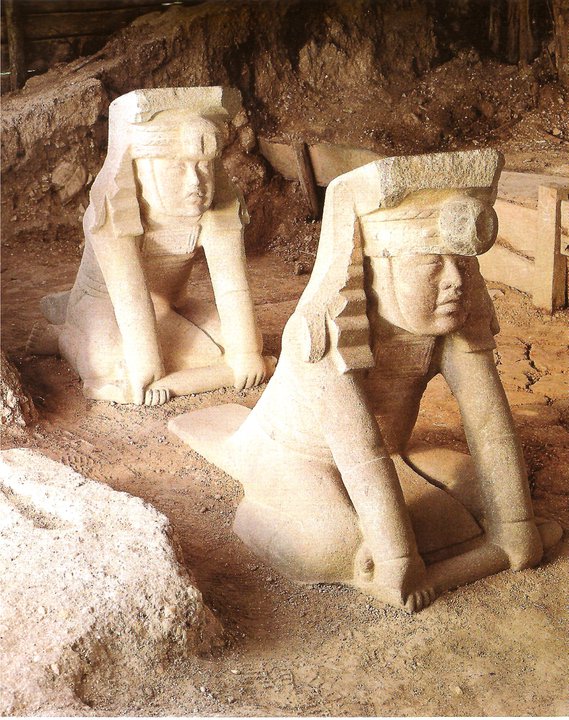El Azuzul is a significant archaeological discovery that consists of two Olmec colossal basalt statues found in the Gulf Coast of Mexico. These statues depict a pair of seated figures, each with a feline at their side, and are believed to date back to the Middle Formative period, roughly 1200-400 BC. The discovery of El Azuzul has provided valuable insights into the Olmec civilization, often considered the mother culture of Mesoamerica.
Get your dose of History via Email
Historical Background of El Azuzul
Archaeologists discovered El Azuzul in 1986 in the southern part of Veracruz, Mexico. The site lies near the ancient Olmec city of San Lorenzo Tenochtitlán. A team led by Ann Cyphers unearthed the statues, which were found lying face down in pairs. The Olmecs, who built and created these statues, inhabited the region and were one of the earliest complex societies in Mesoamerica. They are renowned for their contributions to later Mesoamerican cultures.
The Olmec civilization flourished from around 1400 to 400 BC. They are famous for their colossal heads and intricate artwork. El Azuzul’s statues add to the Olmec legacy, showcasing their artistic prowess. The site where the statues were found was not a scene of any known historically significant events. However, it provides a glimpse into the religious or ceremonial practices of the Olmecs.
There is no clear evidence that El Azuzul was inhabited later by other civilizations. The site appears to have been exclusively Olmec. The statues themselves did not seem to have been moved or altered by later inhabitants. This suggests that the site remained untouched until its modern discovery.
The significance of El Azuzul lies not just in the statues themselves but also in their context. They were found in situ, which means they were discovered in their original placement. This provides archaeologists with valuable information about how the Olmecs displayed such works.
El Azuzul has not been the scene of any historically important events since its creation. Its importance lies in what it reveals about the Olmec civilization. The site remains an essential piece of the puzzle in understanding the complex social and religious structures of early Mesoamerican societies.
About El Azuzul
The El Azuzul statues are made of basalt, a volcanic rock commonly used by the Olmec for their sculptures. The two seated figures are nearly identical, each accompanied by a feline, possibly a jaguar or a jaguar-human hybrid. The craftsmanship of the statues is remarkable, with detailed features and well-proportioned forms.
The figures are seated with their legs crossed and hands resting on their knees. Their postures suggest a sense of calm authority. The felines at their sides add a sense of power and mystique to the statues. The combination of human and animal forms is a recurring theme in Olmec art, reflecting their religious beliefs and cosmology.
The construction of the statues would have required skilled artisans and a deep understanding of the materials. The Olmecs likely used stone tools to carve the basalt, a labor-intensive process. The smooth surfaces and intricate details of the statues are a testament to their advanced techniques.
Architectural highlights of El Azuzul are not well-documented, as the site is primarily known for the statues. However, the Olmec civilization is known for its monumental architecture, including large mounds, plazas, and pyramids, which were likely present in the area surrounding El Azuzul.
The discovery of the El Azuzul statues has provided a deeper understanding of Olmec artistry. The statues are not only significant for their size but also for their artistic expression and the light they shed on Olmec culture.
Theories and Interpretations
Several theories have emerged regarding the purpose and symbolism of the El Azuzul statues. Some scholars suggest they may represent rulers or high priests accompanied by their animal spirits or deities. The jaguar was a potent symbol in Olmec culture, often associated with shamanism and the underworld.
Another theory posits that the statues could be part of a larger narrative or mythological scene. The exact nature of this narrative remains a mystery, but it likely held significant religious or cultural meaning for the Olmecs.
The interpretation of the statues has been matched to historical records by comparing them with other Olmec artifacts. Similar iconography found in other Olmec sites supports the idea of a shared cultural and religious framework.
Dating of the El Azuzul statues has been carried out using context clues from the site. The layer of earth in which they were found and the stylistic analysis of the carvings suggest they belong to the Middle Formative period of the Olmec civilization.
Despite extensive research, certain aspects of the El Azuzul statues remain enigmatic. The lack of written records from the Olmec period means that much of what we understand about these artifacts comes from archaeological interpretation and comparison with other Mesoamerican cultures.
At a glance
Country: Mexico
Civilization: Olmec
Age: Middle Formative period, approximately 1200-400 BC

